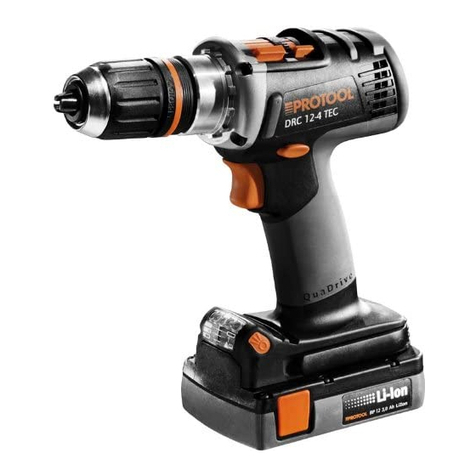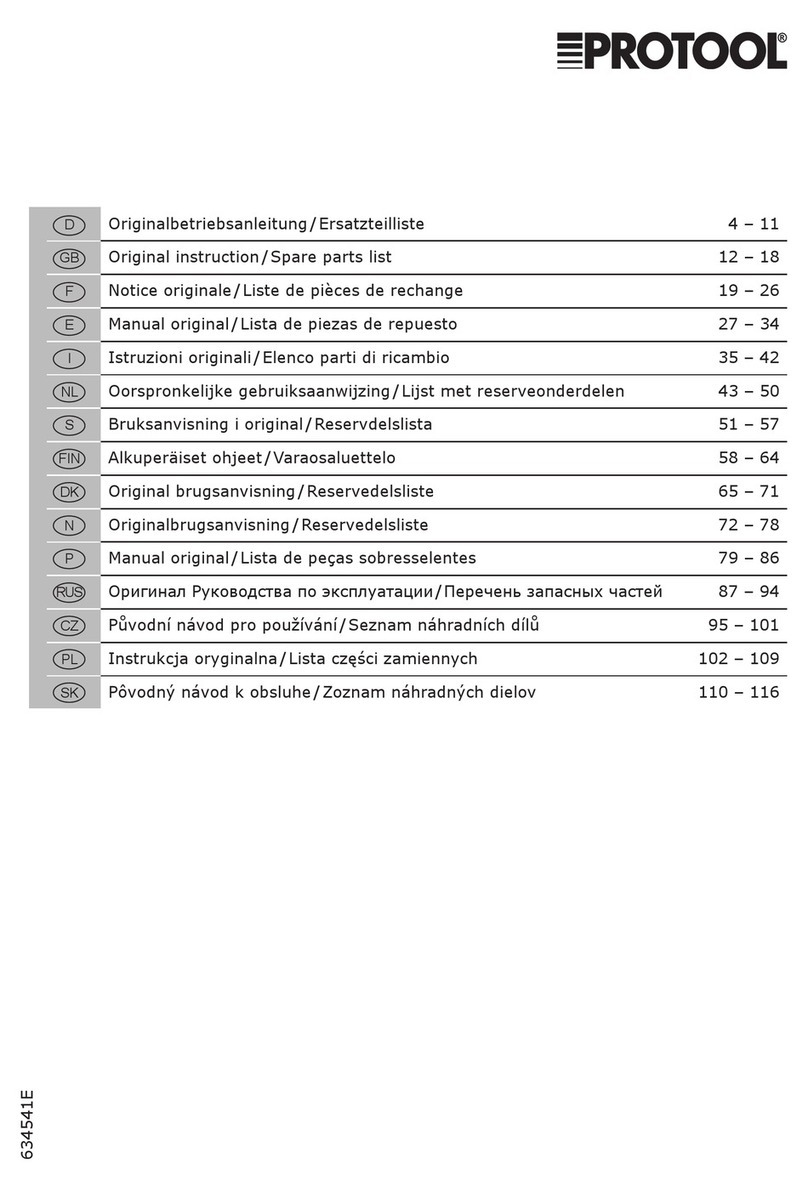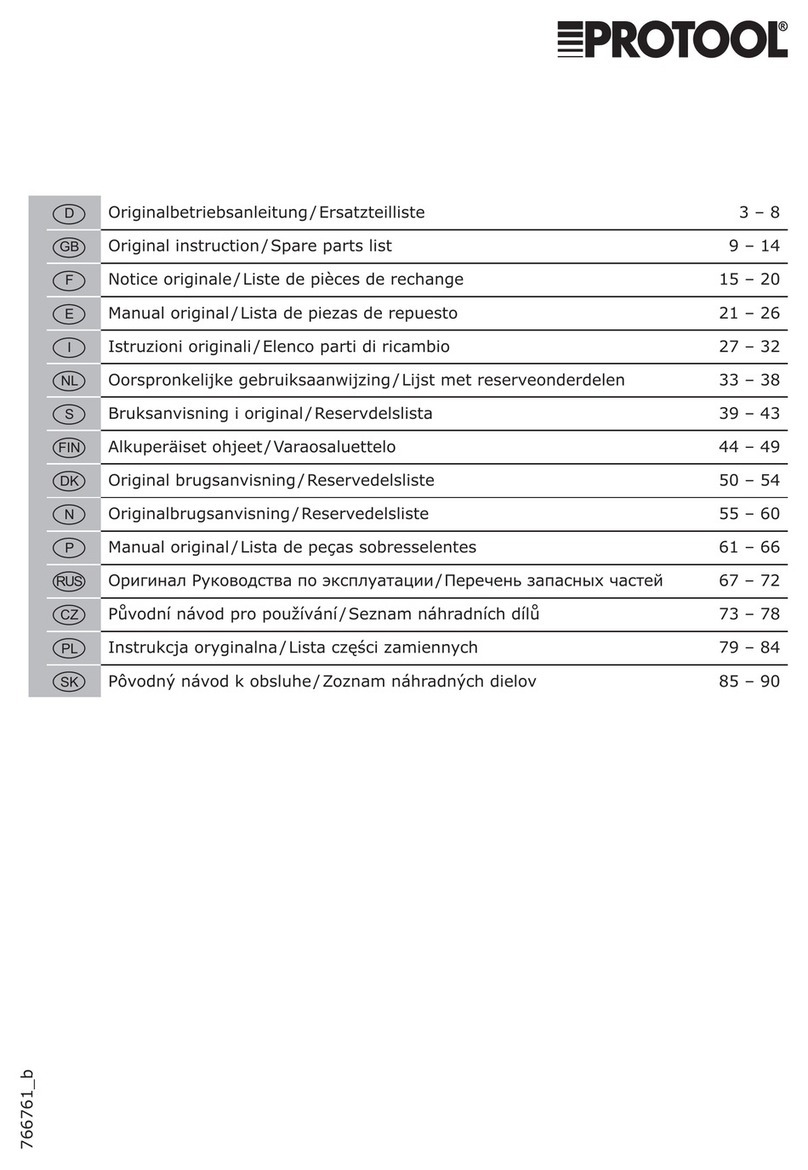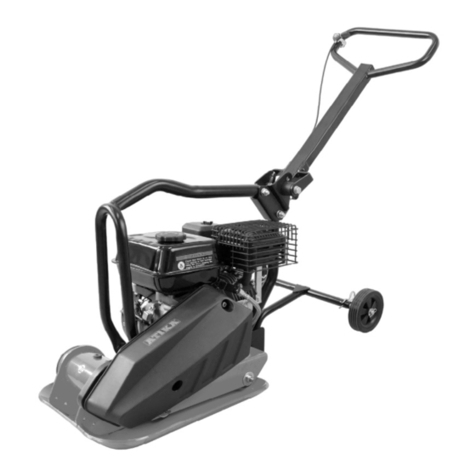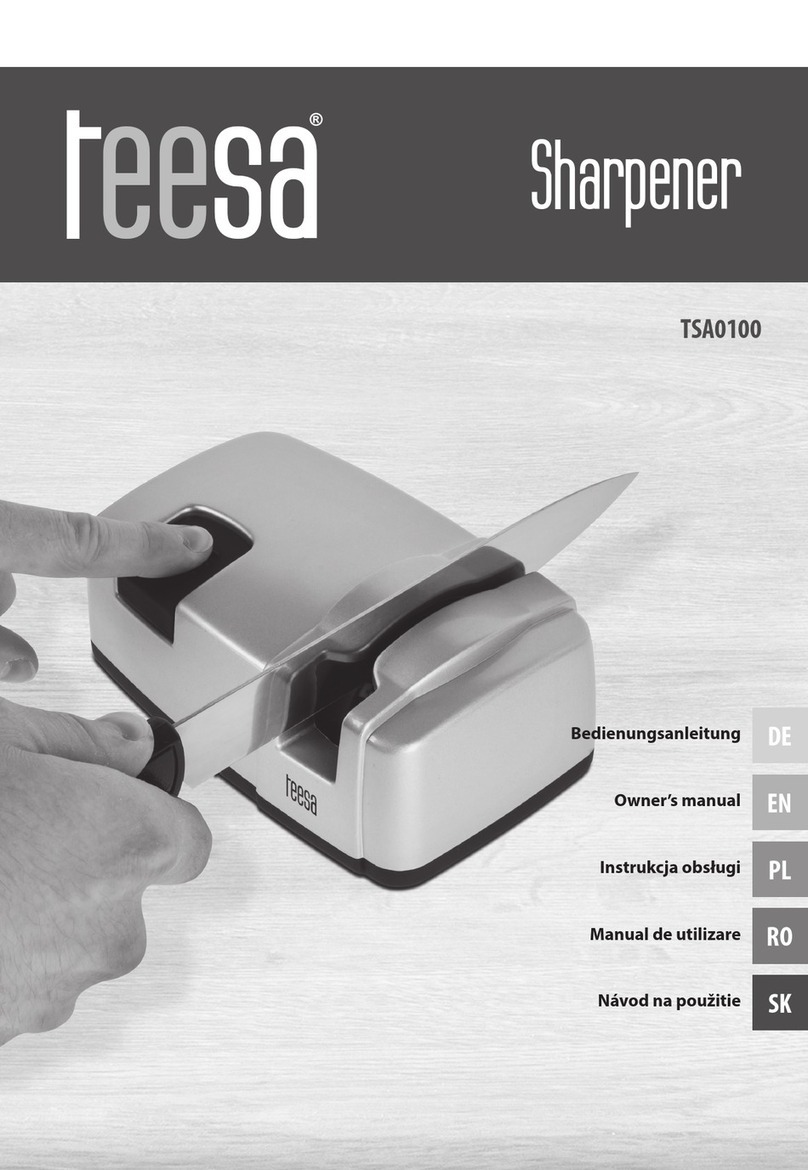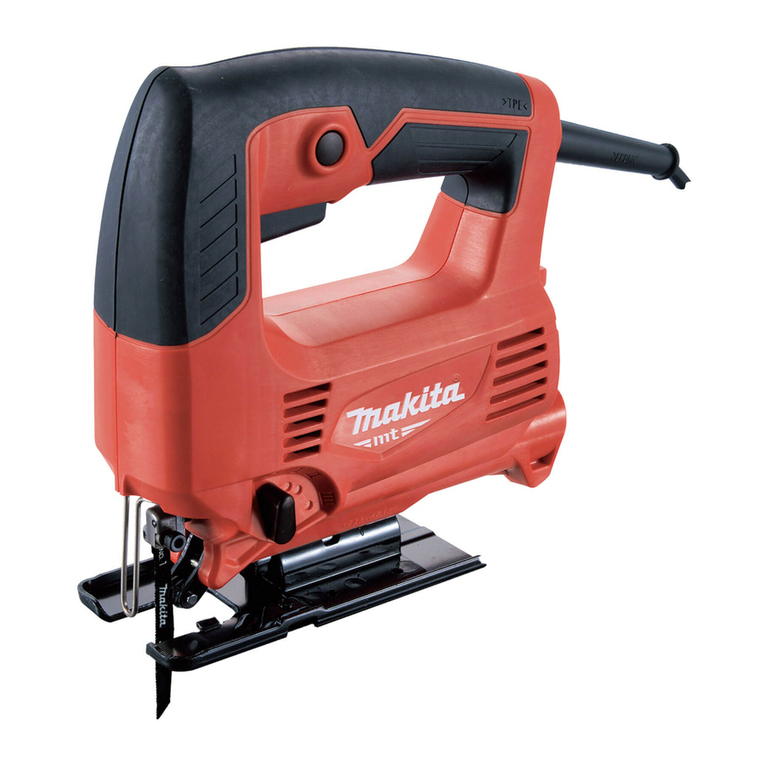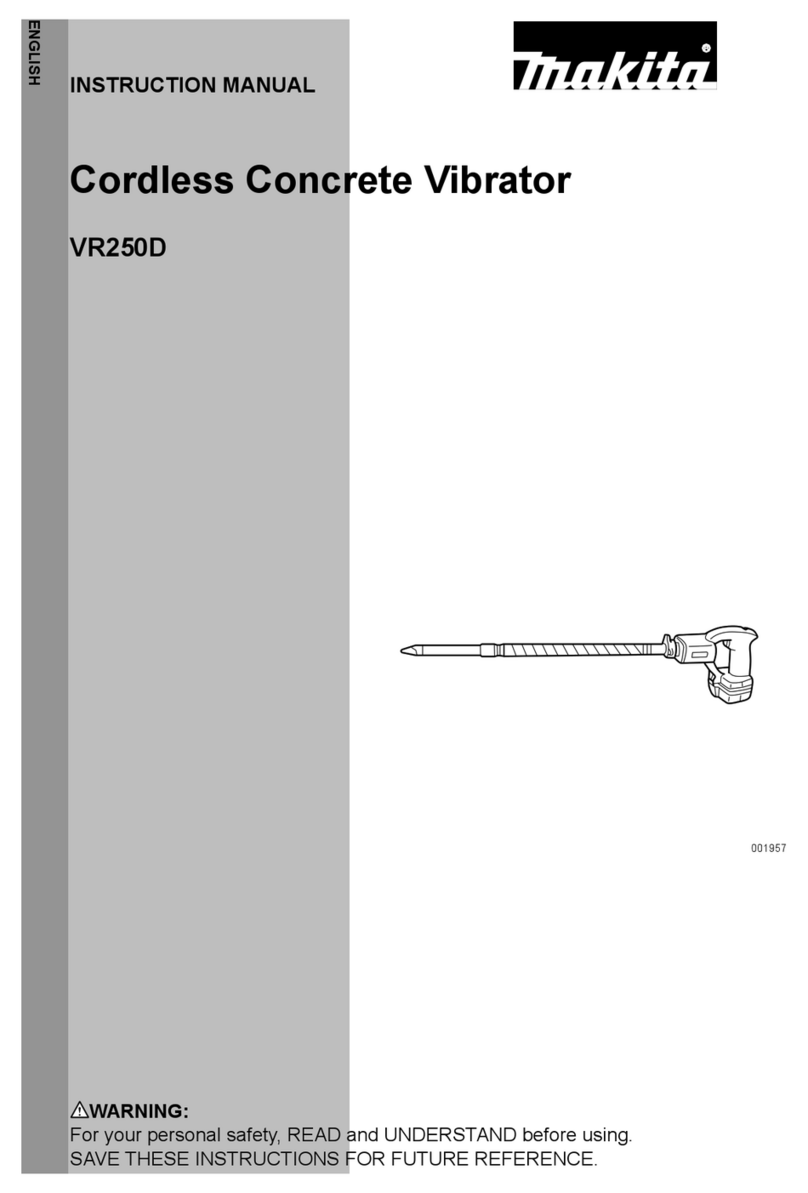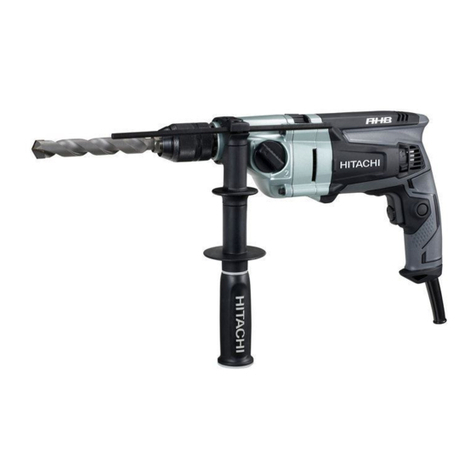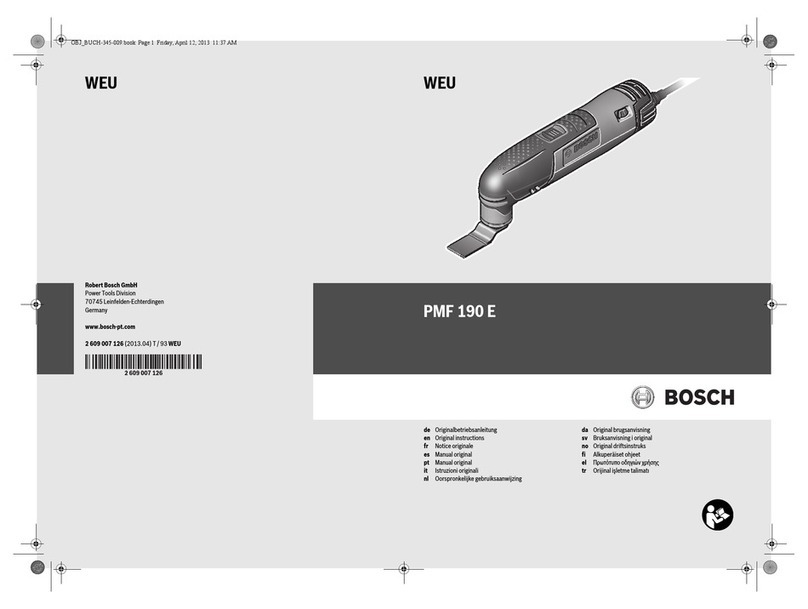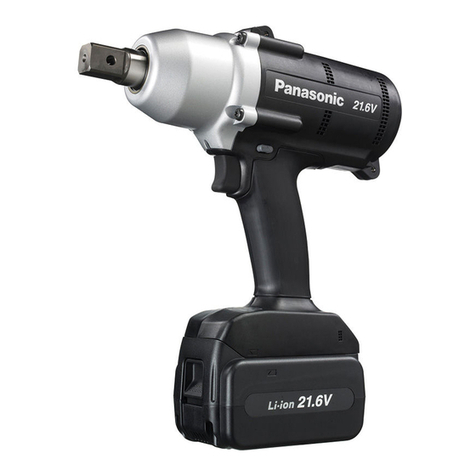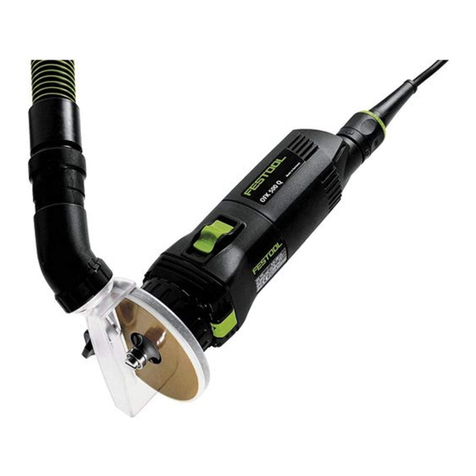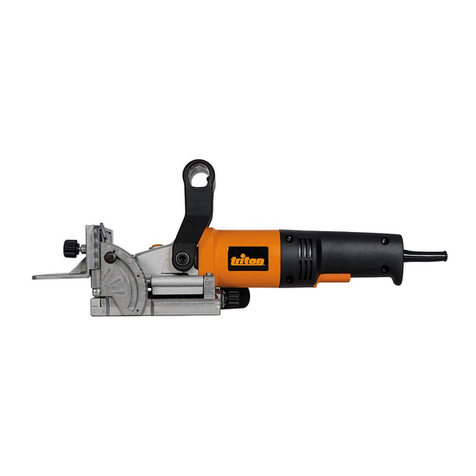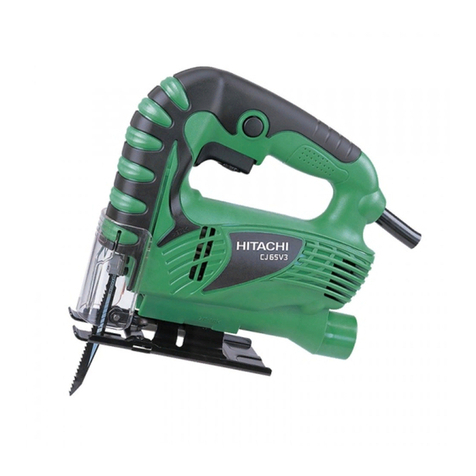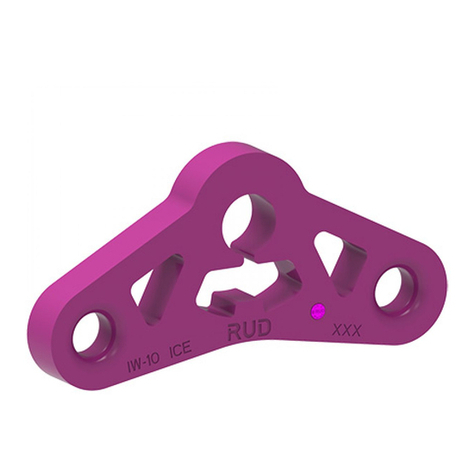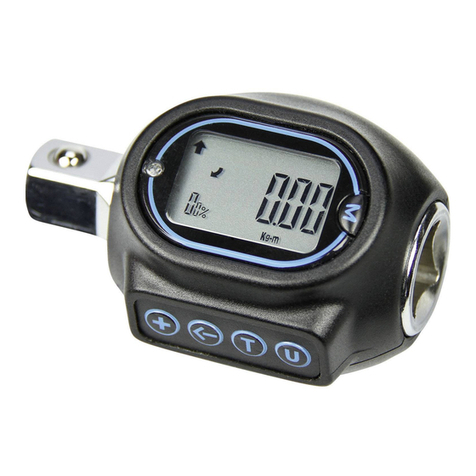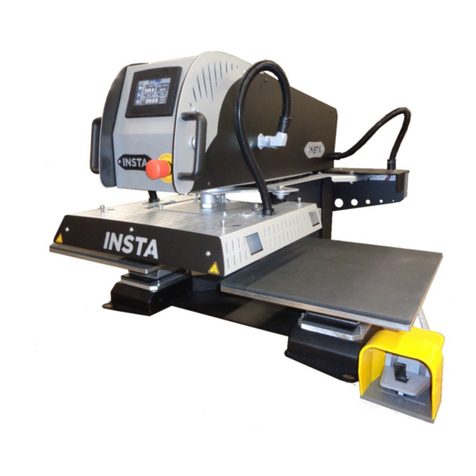Protool PDC 18-4 Compact Operation instructions

704762_001
Originalbetriebsanleitung/ Ersatzteilliste 4
Original instruction/ Spare parts list 9
Notice origine/ Liste de pièces de rechange 14
Manual original/ Lista de piezas de repuesto 20
Istruzioni originali/ Elenco parti di ricambio 26
Originele gebruiksaanwijzing/ Lijst met reserveonderdelen 32
Originalbruksanvisning/ Reservdelslista 38
Alkuperäiset käyttöohjeet/ Varaosaluettelo 43
Original brugsanvisning/ Reservedelsliste 48
Originalbruksanvisning/ Reservedelsliste 53
Manual de instruções original/ Lista de peças sobresselentes 58
Оригинал Руководства по эксплуатации/ Перечень запасных частей 64
Původní návod pro používáni/ Seznam náhradních dílů70
Instrukcja oryginalna/ Lista czêœci zamiennych 75
Pôvodný návod k obsluhe/ Zoznam náhradných dielov 81
PDC 18-4 Compact

1
2 A
1-5
1-6
1-7
1-9
2 B
klick
1
2
1
-
5
1
-
6
1-3
1-2
1-1
1-10
1-11
1-8
1-4

3
4
5
5-1
4 mm
Ø 5 mm
120 mm
3-1
3-2
3-3

4
PDC 18-4 Compact
D
Originalbetriebsanleitung
1 Technische Daten
* Drehzahl-Angaben mit voll geladenem Ak-
kupack. ** In den unteren Drehmomentstufen ist die
maximale Drehzahl reduziert.
2Symbole
Akku-Schlagbohrschrauber PDC 18-4 Compact
Motorspannung 18 V
Leerlaufdrehzahl* 1. Gang 0 - 400 min
-1
2. Gang 0 - 850 min
-1
3. Gang 0 - 1850 min
-1
4. Gang 0 - 3800 min
-1
max. Drehmoment
weicher/ harter Schraubfall 28/ 50 Nm
Drehmoment einstellbar** 1. Gang 0,75 - 12 Nm
2. Gang 0,6 - 7,5 Nm
3. Gang 0,55 - 5 Nm
4. Gang 0,5 - 2,7 Nm
Bohrfutter-Spannbereich 1,5 - 13 mm
Bohrdurchmesser max.
Holz/ Metall 50/ 12 mm
Gewicht 1,8 kg
Ladegerät BCL 3
Netzspannung (Eingang) 220 - 240 V ~
Netzfrequenz 50/60 Hz
Ladespannung (Ausgang) 10,8 - 18 V=
Schnellladung max. 3 A
Erhaltungsladung pulsierend (NiCd, NiMH) ca. 0,06 A
Ladezeiten für
LiIon 1,5 Ah, 80 %/100 % ca. 25/35 min.
Zulässiger Betriebstemperaturbereich -5 °C bis + 45 °C
Temperaturüberwachung mittels NTC-Widerstand
Akkupack BP 18 1,5 Ah LiIon
Spannung 18 V
Kapazität 1,5 Ah
Gewicht 0,4 kg
Warnung vor allgemeiner Gefahr
Warnung vor Stromschlag
Anleitung/Hinweise lesen!
Gehörschutz tragen!
Schutzhandschuhe tragen!
Schutzbrille tragen!

PDC 18-4 Compact
5
D
3Geräteelemente
Die angegebenen Abbildungen befinden sich
am Anfang der Betriebsanleitung.
4 Bestimmungsgemäße Ver-
wendung
Akku-Schlagbohrschrauber geeignet
– zum Bohren in Metall, Holz, Kunststoffen
und ähnlichen Materialien,
– zum Schlagbohren in Mauern, Beton und
ähnlichen Baumaterialien,
– zum Ein- und Festschrauben von Schrau-
ben.
Ladegerät BCL 3 geeignet
– zum Aufladen der Akkupacks: Protool BP,
Festool BPS und BPC (NiMH, NiCd, LiIon
werden automatisch erkannt.)
– nur für Innengebrauch.
Bei nicht bestimmungsgemäßem Ge-
brauch haftet der Benutzer.
5 Sicherheitshinweise
5.1 Allgemeine Sicherheitshinweise
Warnung! Lesen Sie sämtliche Si-
cherheitshinweise und Anweisun-
gen.
Fehler bei der Einhaltung der Warnhin-
weise und Anweisungen können elektrischen
Schlag, Brand und/oder schwere Verletzun-
gen verursachen.
Bewahren Sie alle Sicherheitshinweise
und Anweisungen für die Zukunft auf.
Der in den Sicherheitshinweisen verwendete
Begriff „Elektrowerkzeug“ bezieht sich auf
netzbetriebene Elektrowerkzeuge (mit Netz-
kabel) und auf akkubetriebene Elektrowerk-
zeuge (ohne Netzkabel).
5.2 Maschinenspezifische Sicher-
heitshinweise
–
Halten Sie das Gerät nur an den iso-
lierten Griffflächen, wenn Sie Arbeiten
ausführen, bei denen das Einsatz-
werkzeug verborgene Stromleitungen
treffen kann.
Der Kontakt mit einer span-
nungsführenden Leitung kann auch metal-
lene Geräteteile unter Spannung setzen
und zu einem elektrischen Schlag führen.
–
Tragen Sie geeignete persönliche
Schutzausrüstungen:
Gehörschutz,
Schutzbrille, Staubmaske bei stauberzeu-
genden Arbeiten, Schutzhandschuhe beim
Bearbeiten rauer Materialien und beim
Werkzeugwechsel.
– Ein-/Ausschalter nicht dauerhauft arretie-
ren!
– Behinderte und beeinträchtigte Personen
sowie Kinder dürfen dieses Gerät nicht
oder nur unter Aufsicht benutzen.
– Akkupack und Ladegerät nicht öffnen!
– Ladegerät vor Metallteilen (z. B. Metallspä-
ne) oder Flüssigkeiten schützen!
– Keine Fremd-Akkupacks, keine Fremd-La-
degeräte verwenden!
Atemschutz tragen!
Nicht in den Hausmüll geben.
[1-1]
Bit-Depot
[1-2]
Kapazitätsanzeige
[1-3]
LED-Lampe
[1-4]
Umschalter Bohren/Schlagbohren
[1-5]
Gang-Schalter
[1-6]
Einstellrad Drehmoment
[1-7]
Schalter für Rechts-/Links-Lauf
[1-8]
Ein-/Ausschalter
[1-9]
Gürtelclip
[1-10]
Akkupack
[1-11]
Taste zum Lösen des Akkupacks
[3-1]
Halterung für Akkupack
[3-2]
LED-Anzeige
[3-3]
Kabelaufwicklung
[4]
Wandbefestigung
[5-1]
Spannhülse
VORSICHT
Rückschlag
X
Drehung: Gerät sofort ausschalten!

6
PDC 18-4 Compact
D
– Akkupack vor Hitze z. B. auch vor dauern-
der Sonneneinstrahlung und Feuer schüt-
zen!
– Brennende LiIon-Akkupacks nie mit Was-
ser löschen! Sand oder Feuerlöschdecke
verwenden.
– Das Gerät vor Nässe schützen.
– Das Kabel vor Hitze, Öl und scharfen Kan-
ten schützen.
– Regelmäßig den Stecker und das Kabel
prüfen und diese bei Beschädigung von ei-
ner autorisierten Kundendienst-Werkstätte
erneuern lassen.
5.3 Emissionswerte
Die nach EN 60745 ermittelten Werte betra-
gen typischerweise:
Schwingungsemissionswert a
h
(Vektorsum-
me dreier Richtungen) und Unsicherheit K
ermittelt entsprechend EN 60745:
Die angegebenen Emissionswerte (Vibration,
Geräusch)
– dienen dem Maschinenvergleich,
– eignen sich auch für eine vorläufige Ein-
schätzung der Vibrations- und Geräusch-
belastung beim Einsatz,
– repräsentieren die hauptsächlichen An-
wendungen des Elektrowerkzeugs.
Erhöhung möglich bei anderen Anwendun-
gen, mit anderen Einsatzwerkzeugen oder
ungenügend gewartet. Leerlauf- und Still-
standszeiten der Maschine beachten!
6 Inbetriebnahme
6.1 Kabelaufwicklung Ladegerät [3-
3]
Vor Inbetriebnahme muss das Kabel
vollständig von der Aussparung abge-
wickelt werden.
6.2 Akkupack wechseln
Akkupack abnehmen [2 B]
Akkupack einsetzen [2 A]
6.3 Akkupack laden [3]
L
Der Akkupack wird teilgeladen ausgelie-
fert. Akkupack vor der ersten Benutzung
vollständig aufladen.
Die LED
[3-2]
des Ladegeräts zeigt den je-
weiligen Betriebszustand des Ladegerätes
an.
Bohren
Schalldruckpegel L
PA
= 69 dB(A)
Schallleistungspegel L
WA
= 78 dB(A)
Unsicherheit K = 3 dB
Schlagbohren
Schalldruckpegel L
PA
= 99 dB(A)
Schallleistungspegel L
WA
= 108 dB(A)
Unsicherheit K = 3 dB
VORSICHT
Beim Arbeiten eintretender Schall
Schädigung des Gehörs
X
Benutzen Sie einen Gehörschutz!
Bohren in Metall a
h
< 2,5 m/s
2
K = 1,5 m/s
2
Schrauben a
h
< 2,5 m/s
2
K = 1,5 m/s
2
Schlagbohren in Beton a
h
= 16,8 m/s
2
K = 3,0 m/s
2
LED gelb - Dauerlicht
Ladegerät ist betriebsbereit.
LED grün - schnelles Blin-
ken
Akkupack wird mit maxima-
lem Strom geladen.
LED grün - langsames
Blinken
Akkupack wird mit reduzier-
tem Strom geladen, LiIon ist
zu 80 % geladen.
LED grün - Dauerlicht
Ladevorgang ist beendet oder
wird nicht neu gestartet, da
aktueller Ladezustand grö-
ßer 80 %.
LED rot - Blinken
Allgemeine Fehleranzeige, z.
B. keine vollständige Kontak-
tierung, Kurzschluss, Akku-
pack defekt, usw..

PDC 18-4 Compact
7
D
6.4 Beleuchtung und Akku-Kapazi-
tätsanzeige
Die LED der Lampe
[1-3]
dient als
Beleuchtung und als Akku-Kapazi-
tätsanzeige
[1-2]
.
Sie zeigt automatisch bei Betätigung des Ein-
/Ausschalters
[1-8]
den Ladezustand des
Akkupacks an (nicht mit NiCd- und NiMH-Ak-
kupacks).
7 Einstellungen
7.1 Drehrichtung ändern [1-7]
• Schalter nach links = Rechtslauf
• Schalter nach rechts = Linkslauf
7.2 Gang wechseln
Mit dem Gang-Schalter
[1-5]
kann das Ge-
triebe umgeschalten werden.
7.3 Drehmoment einstellen [1-6]
Schrauben
Drehmoment entsprechend Einstellung:
Stellung 1 = kleines Drehmoment
Stellung 12 = hohes Drehmoment
Signalton
bei Erreichen des eingestellten
Drehmomentes, Maschine schaltet ab. Ma-
schine läuft erst wieder, wenn der Ein-/Aus-
schalter
[1-8]
losgelassen und erneut ge-
drückt wird.
Bohren
Markierung zeigt auf Bohrersymbol = ma-
ximales Drehmoment.
7.4 Schlagbohren
L
Das Gerät ist bestimmt zum Schlagboh-
ren in Ziegel, Mauerwerk und Stein.
Den Umschalter
[1-4]
auf das Hammersym-
bol stellen. Dabei Stellrad
[1-6]
auf Bohr-
symbol stellen.
7.5 Werkzeug wechseln
Spannhülse
[5-1]
gegen den Uhrzeigersinn
drehen um die Spannbacken zu öffnen. Der
Pfeil auf der Spannhülse gibt die Drehrich-
tung zum Öffnen vor. Das Werkzeug kann in
das Bohrfutter eingesetzt werden.
Spannhülse
[5-1]
im Uhrzeigersinn drehen
um das Werkzeug festzuspannen
8 Arbeiten mit der Maschine
8.1 Ein-/Ausschalten [1-8]
Drücken = EIN, Loslassen = AUS
L
Je nach Druck auf den Ein-/Ausschalter ist
die Drehzahl stufenlos steuerbar.
8.2 Bit-Depot [1-1]
Magnetisch, zur Aufnahme von Bits oder
Bithaltern.
8.3 Gürtelclip [1-9]
Der Gürtelclip (rechts/ links) ermöglicht ein
kurzfristiges Befestigen des Gerätes an der
Arbeitskleidung.
8.4 Akustische Warnsignale
Akustische Warnsignale ertönen bei folgen-
den Betriebszuständen und die Maschine
schaltet ab:
LED rot - Dauerlicht
Akkutemperatur ist außer-
halb der zulässigen Grenz-
werte.
LED grün – Dauerlicht:
Ladezustand >60 %
LED grün – langsames
blinken:
Ladezustand 30 %
– 60 %
LED grün – schnelles
blinken:
Ladezustand 0 %
- 30 %
LED gelb – Dauerlicht:
Akku ist leer
LED rot – Dauerlicht:
Akkutemperatur ist außer-
halb der zulässigen Grenz-
werte.
LED rot – blinken:
Allge-
meine Fehleranzeige, z. B.
keine vollständige Kontak-
tierung, Kurzschluss, Akku-
pack defekt, usw.
WARNUNG
Verletzungsgefahr
X
Einstellungen nur bei ausgeschalteter Ma-
schine!
VORSICHT
Verletzungsgefahr
X
Spannen Sie das Werkzeug zentrisch im
Bohrfutter ein!

8
PDC 18-4 Compact
D
9 Wartung und Pflege
Folgende Hinweise beachten:
– Die Lüftungsöffnungen am Elektrowerk-
zeug frei und sauber halten, damit die
Kühlung gewährleistet ist.
– Die Anschlusskontakte am Elektrowerk-
zeug, Ladegerät und Akkupack sauber hal-
ten.
Hinweise zu Akkupacks
– Lagerung an trockenem, kühlen Ort bei ei-
ner Temperatur von 5 °C bis 25 °C.
– Akkupacks vor Feuchtigkeit und Wasser
sowie vor Hitze schützen.
– Leere Akkupacks nicht länger als ca. einen
Monat im Ladegerät stecken lassen, wenn
das Ladegerät vom Netz getrennt ist. Ge-
fahr der Tiefentladung!
– Werden LiIon-Akkupacks längere Zeit ohne
Benutzung gelagert, sollten sie mit 40 %
Kapazität (ca. 15 min Ladedauer) aufgela-
den sein.
9.1 Kundendienst und Reparatur
Nur durch Hersteller oder durch
Servicewerkstätten. Nächstgele-
gene Adresse unter:
www.protool-online.com/service
Nur original Protool Ersatzteile
verwenden! Bestell-Nr. unter
www.protool-online.com/service
10 Umwelt
Gerät nicht in den Hausmüll
werfen!
Geräte, Zubehör und
Verpackungen einer umweltge-
rechten Wiederverwertung zufüh-
ren. Geltende nationalen Vor-
schriften beachten.
Nur EU:
Gemäß Europäischer Richtlinie
2002/96/EG müssen verbrauchte Elektro-
geräte getrennt gesammelt und einer um-
weltgerechten Wiederverwertung zugeführt
werden.
Verbrauchte oder defekte Akkupacks
über Fachhandel, Protool-Kundendienst oder
öffentlich vorgeschriebene Entsorgungsein-
richtungen zurückgeben (geltende Vorschrif-
ten beachten). Akkus müssen bei Rückgabe
entladen sein. Akkupacks werden so einem
geordneten Recycling zugeführt.
Nur EU:
Gemäß Europäischer Richtlinie 91/
157/EWG müssen defekte oder verbrauchte
Akkupacks/Batterien recycelt werden.
Informationen zur REACh:
www.protool-
online.com/reach
11 Transport
Ein LiIon-Akkupack alleine unterschreitet die
einschlägigen Grenzwerte nach UN-Hand-
buch ST/SG/ AC.10/11/Rev.3 Teil III, Unter-
abschnitt 38.3. Beim Transport mehrerer Ak-
kupacks können Gefahrgutvorschriften rele-
vant sein.
12 EG-Konformitätserklärung
Wir erklären in alleiniger Verantwortung,
dass dieses Produkt mit folgenden Richtlinien
und Normen übereinstimmt:
2006/42/EG, 2004/108/EG, 2011/65/EU (ab
03.01.2013), EN 60745-1, EN 60745-2-1,
EN 60745-2-2, EN 55014-1, EN 55014-2.
Wir erklären in alleiniger Verantwortung,
dass dieses Produkt mit folgenden Richtlinien
und Normen übereinstimmt:
2004/108/EG, 2006/95/EG, 2011/65/EU (ab
03.01.2013), EN 60335-1, EN 60335-2-29,
EN 61000-3-2, EN 61000-3-3, EN 61204-3.
Festool Group GmbH & Co. KG
Wertstr. 20, D-73240 Wendlingen
Dr. Johannes Steimel
Leiter Forschung, Entwicklung, technische
Dokumentation
03.04.2012
– Eingestelltes Drehmoment erreicht.
– "Block protect"; Anlaufmoment zu
hoch.
– Maschine überlastet
peep
EKAT
1
235
4
Akku-Schlagbohr-
schrauber Serien-Nr.
PDC 18-4 Compact 498303
Jahr der CE-Kennzeichnung: 2012
Ladegerät Serien-Nr.
BCL 3 10004913
Jahr der CE-Kennzeichnung: 2012

PDC 18-4 Compact
9
GB
Original operating manual
1 Technical data
* Speed specifications with fully charged bat-
tery pack. ** The maximum speed is reduced in the
lower torque stages.
2Symbols
Cordless impact drill PDC 18-4 Compact
Motor voltage 18 V
Idling speed* 1st gear 0 - 400 rpm
2nd gear 0 - 850 rpm
3rd gear 0 - 1850 rpm
4th gear 0 - 3800 rpm
Max. torque
soft/ hard material 28/ 50 Nm
Adjustable torque** 1st gear 0,75 - 12 Nm
2nd gear 0,6 - 7,5 Nm
3rd gear 0,55 - 5 Nm
4th gear 0,5 - 2,7 Nm
Chuck clamping range 1,5 - 13 mm
Drill diameter max.
Wood/ Metal 50/ 12 mm
Weight 1,8 kg
Charger BCL 3
Mains voltage (input) 220 - 240 V ~
Mains frequency 50/60 Hz
Charging voltage (output) 10.8 - 18 V=
Rapid charging max. 3 A
Conservation charging, intermittent (NiCd, NiMH) approx. 0.06 A
Charging times for
Li-ion 1.5 Ah, 80 %/100 % approx. 25/35 min.
Permitted operating temperature range -5 °C to + 45 °C
Temperature monitoring with NTC resistor
Battery pack BP 18 1,5 Ah LiIon
Voltage 18 V
Capacity 1,5 Ah
Weight 0,4 kg
Warning of general danger
Risk of electric shock
Read the Operating Instructions/
Notes!
Wear ear protection.
Wear protective gloves.
Wear protective goggles.

10
PDC 18-4 Compact
GB
3 Machine features
The specified illustrations appear at the be-
ginning of the Operating Instructions.
4Intendeduse
Cordless impact drills are suitable for
– drilling in metal, wood, plastic and similar
materials,
– impact drilling into walls, concrete and
similar building materials,
– inserting and tightening screws
Charger BCL 3 is suitable for
– charging battery packs: Protool BP, Festool
BPS and BPC (NiMH, NiCd, li-ion are recog-
nised automatically.)
– internal use only.
The user is liable for improper or non-
intended use.
5 Safety instructions
5.1 General safety instructions
WARNING! Read all safety warn-
ings and all instructions.
Failure to
follow the warnings and instructions may re-
sult in electric shock, fire and/or serious in-
jury.
Save all warnings and instructions for
future reference.
The term "power tool" in the warnings refers
to your mains-operated (corded) power tool
or battery-operated (cordless) power tool.
5.2 Machine-related safety instruc-
tions
–
Hold power tool by insulated gripping
surfaces, when performing an opera-
tion where the cutting accessory may
contact hidden wiring or its own cord.
Cutting accessory contacting a "live" wire
may make exposed metal parts of the
power tool "live" and could give the opera-
tor an electric shock.
–
Wear suitable protection:
such as ear
protection, safety goggles, a dust mask for
work which generates dust, and protective
gloves when working with raw materials
and when changing tools.
– Do not lock the on/off switch permanently!
– Handicapped and impaired persons or chil-
dren are not permitted to use this machine
or only under supervision.
– Do not open the battery pack or the charg-
er!
– Prevent metal parts (e.g. metal chips) or
fluids from entering the charger!
– Do not use battery packs or chargers from
other manufacturers!
– Protect the battery pack from excessive
heat or constant heat sources such as sun-
light or naked flames!
– Never use water to extinguish burning li-
ion battery packs! Use sand or a fire blan-
ket.
Wear a dust mask.
Do not throw in the household waste.
[1-1]
Bit store
[1-2]
Capacity display
[1-3]
LED lamp
[1-4]
Drilling/impact drilling selector
switch
[1-5]
Gear switch
[1-6]
Torque thumbwheel
[1-7]
Right/left switch
[1-8]
On/Off switch
[1-9]
Belt clip
[1-10]
Battery pack
[1-11]
Button for releasing the battery
pack
[3-1]
Holder for battery pack
[3-2]
LED-Display
[3-3]
Cable holder
[4]
Wall mount
[5-1]
Clamping sleeve
CAUTION
Recoil
X
Rotation: switch off machine immediately!

PDC 18-4 Compact
11
GB
– Protect the machine from moisture.
– Protect the cable from heat, oil and sharp
edges.
– Check the plug and the cable regularly and
should either become damaged, have
them replaced by an authorised after-sales
service workshop.
5.3 Emission levels
Levels determined in accordance with EN
60745 are typically:
Vibration emission value a
h
(vector sum for
three directions) and uncertainty K mea-
sured in accordance with EN 60745:
The specified emissions values (vibration,
noise)
– are used to compare machines.
– They are also used for making preliminary
estimates regarding vibration and noise
loads during operation.
– They represent the primary applications of
the power tool.
Increase possible for other applications, with
other insertion tools or if not maintained ad-
equately. Take note of idling and downtimes
of machine!
6Operation
6.1 Charger cable holder[3-3]
Unwind the cable completely from the
recess before using the charger.
6.2 Changing the battery pack
Removing the battery pack[2 B]
Inserting the battery pack [2 A]
6.3 Charging the battery pack [3]
L
The battery pack is delivered partially
charged. Charge the battery pack com-
pletely before using for the first time.
The LED
[3-2]
on the charger indicates the
respective operating status of the charger.
6.4 Light and battery capacity indi-
cator
The LED on the lamp
[1-3]
is both a
light and a battery capacity indicator
[1-2]
.
The LED automatically indicates the charging
state of the battery pack (not NiCd and NiMH
battery packs) when the on/off switch
[1-8]
is pressed.
Drilling
Sound pressure level L
PA
= 69 dB(A)
Noise level L
WA
= 78 dB(A)
Uncertainty K = 3 dB
Impact drilling
Sound pressure level L
PA
= 99 dB(A)
Noise level L
WA
= 108 dB(A)
Uncertainty K = 3 dB
CAUTION
When working with noise
Damage to hearing
X
Always use ear protection.
Drilling into metal a
h
< 2,5 m/s
2
K = 1,5 m/s
2
Fastening a
h
< 2,5 m/s
2
K = 1,5 m/s
2
Impact drilling into
concrete a
h
= 16,8 m/s
2
K = 3,0 m/s
2
LED yellow - lit continu-
ously
Charger is ready to use.
LED green - flashing
quickly
Battery pack is charged to
maximum capacity.
LED green - flashing
slowly
Battery pack is charged with
reduced current. LiIon is
charged to 80 %.
LED green - lit continu-
ously
Charging is complete or is not
restarted as current charge
status is greater than 80%.
LED red - flashing
General fault display, e.g.
incomplete contact, short cir-
cuit, defective battery pack,
etc.
LED red - lit continuously
Battery temperature is out-
side the permitted range.

12
PDC 18-4 Compact
GB
7 Settings
7.1 Changing direction of rotation
[1-7]
• Switch to the left = clockwise rotation
• Switch to the right = counterclockwise ro-
tation
7.2 Changing gear
You can change gear using the gear switch
[1-5]
.
7.3 Adjusting the torque[1-6]
Fastening
Select the correct torque setting:
Position 1 = low torque
Position 12 = high torque
An
acoustic signal
sounds when the preset
torque is reached and the machine then
switches off. You must release and press the
ON/OFF switch
[1-8]
again to start the ma-
chine.
Drilling
Mark is aligned with drill symbol = maxi-
mum torque.
7.4 Impact drilling
L
The machine was designed for impact
drilling into tiles, masonry and stone.
Set the selector switch
[1-4]
to the hammer
symbol. Set the adjusting wheel
[1-6]
to the
drill symbol.
7.5 Changing tools
Turn the clamping sleeve
[5-1]
anticlock-
wise to open the jaws. The arrow on the
clamping sleeve indicates the opening direc-
tion. The tool can now be inserted into the
drill chuck.
Turn the clamping sleeve
[5-1]
clockwise to
clamp the tool securely
8 Working with the machine
8.1 On/Off switch [1-8]
Press = ON, release = OFF
L
The speed of the machine depends on
how far the on/off switch is pressed in.
8.2 Bit depot [1-1]
Magnetic, for storing bits and bit holders.
8.3 Belt clip [1-9]
The user can attach the machine to work
clothing for short periods using the belt clip
(right/left).
8.4 Acoustic warning signals
Acoustic warning signals sound and the ma-
chine switches off in the following operating
states:
9 Service and maintenance
Note the following information:
– Keep the ventilation slits on the machine
free and clean to ensure adequate cooling.
– Keep the contacts on the machine, charger
and battery pack clean.
LED green – lit continu-
ously:
charged > 60 %
LED green – flashing
slowly:
charged 30 % – 60
%
LED green – flashing
quickly:
charged 0 % – 30
%
LED yellow – lit continu-
ously:
battery is empty
LED red – lit continu-
ously:
battery temperature
is outside the permitted
range.
LED red – flashing:
indi-
cates a general fault, e.g.
incomplete contact, short
circuit, battery pack faulty,
etc.
WARNING
Risk of injury
X
Always switch off the machine before ad-
justing settings!
CAUTION
Risk of injury
X
Clamp the tool centrally in the drill chuck!
– Preset torque reached.
– "Block protect" - starting torque too
high.
– Machine overloaded
peep

PDC 18-4 Compact
13
GB
Information on battery packs
– Store in a cool, dry place at a temperature
between 5 °C and 25 °C.
– Protect battery packs from moisture, water
and heat.
– Do not leave flat battery packs in a charger
disconnected from the mains power supply
for longer than one month. Danger of deep
discharge!
– If you intend to store li-ion battery packs
for longer periods without use, you should
charge them to 40 % capacity (approx. 15
min charging time).
9.1 After-sales service and repair
Always contact the manufacturer
or an authorised service work-
shop. Visit www.protool-on-
line.com/service to locate your
nearest service point
Always use original Protool spare
parts! Visit www.protool-on-
line.com/service for the relevant
order numbers
10 Environment
Do not dispose of the device in
household waste!
Recycle de-
vices, accessories and packaging.
Observe applicable country-spe-
cific regulations.
EU only:
European Directive 2002/96/EC
stipulates that used electric power tools must
be collected separately and disposed of at an
environmentally responsible recycling cen-
tre.
Return used or faulty battery packs
to
your local specialist retailer, Protool after-
sales service or nearest public waste man-
agement facility (observe applicable regula-
tions). Batteries must be discharged on re-
turn. Battery packs will then be recycled.
EU only:
European Directive 91/157/EEC
stipulates that faulty or used battery packs/
batteries must be recycled.
Information on REACh:
www.protool-on-
line.com/reach
11 Transport
The equivalent amount of lithium in the LiIon
battery pack is less than the applicable limit
value and certified as per UN manual ST/SG/
AC.10/11/rev. 3 part III, subsection 38.3.
The LiIon battery pack is therefore not sub-
ject to national and international dangerous
goods regulations, neither as an individual
component nor as a fitted machine compo-
nent. However, dangerous goods regulations
may apply when several battery packs are
transported, in which case you may have to
fulfil special conditions. Refer to ADR special
regulation 230 for more information relevant
for the EU.
12 EU Declaration of Conformi-
ty
We declare under sole responsibility that this
product complies with the following direc-
tives and standards:
2006/42/EC, 2004/108/EC, 2011/65/EU
(from 03.01.2013), EN 60745-1, EN 60745-
2-1, EN 60745-2-2, EN 55014-1, EN 55014-
2.
We declare under sole responsibility that this
product complies with the following direc-
tives and standards:
2004/108/EC, 2006/95/EC, 2011/65/EU (af-
ter 03.01.2013), EN 60335-1, EN 60335-2-
29, EN 61000-3-2, EN 61000-3-3, EN
61204-3.
Festool Group GmbH & Co. KG
Wertstr. 20, D-73240 Wendlingen, Germany
Dr. Johannes Steimel
Head of Research, Development and Techni-
cal Documentation
03.04.2012
EKAT
1
235
4
Cordless impact drill Serial no.
PDC 18-4 Compact 498303
Year of CE mark: 2012
Charger Serial no.
BCL 3 10004913
Year of CE mark: 2012

14
PDC 18-4 Compact
F
Notice d'utilisation d'origine
1 Caractéristiques techniques
* Indications de vitesse de rotation avec bat-
terie entièrement chargée. ** La vitesse de rotation maximale est rédui-
te dans les plages de couple inférieures.
2Symboles
Perceuse-visseuse à percussion sans fil PDC 18-4 Compact
Tension du moteur 18 V
Vitesse à vide * 1ère vitesse
0 - 400
min
-1
2ème vitesse
0 - 850
min
-1
3ème vitesse
0 - 1850
min
-1
4ème vitesse
0 - 3800
min
-1
Couple max.
Vissage dans support tendre/dur 28/ 50 Nm
Couple réglable ** 1ère vitesse 0,75 - 12 Nm
2ème vitesse 0,6 - 7,5 Nm
3ème vitesse 0,55 - 5 Nm
4ème vitesse 0,5 - 2,7 Nm
Mandrin de perçage, plage de serrage 1,5 - 13 mm
Diamètre de perçage max.
Bois/métal 50/ 12 mm
Poids 1,8 kg
Chargeur BCL 3
Puissance (entrée) 220 - 240 V ~
Fréquence 50/60 Hz
Tension de charge (sortie) 10,8 - 18 V =
Charge rapide max. 3 A
Charge de compensation, pulsée (NiCd, NiMH) env. 0,06 A
Temps de charge pour
Li-Ion 1,5 Ah, 80 %/100 % env. 25/35 min.
Plage de température de fonctionnement admissible de -5 °C à + 45 °C
Surveillance de la température au moyen d'une résistance
CTN
Bloc batteries BP 18 1,5 Ah LiIon
Tension 18 V
Capacité 1,5 Ah
Poids 0,4 kg
Avertissement de danger général
Risque d'électrocution
Lire les instructions / les remarques !
Portez des protège-oreilles!
Porter des gants de protection !
Porter des lunettes de protection !

PDC 18-4 Compact
15
F
3 Composants de l’appareil
Les illustrations indiquées se trouvent au dé-
but de la notice d'utilisation.
4 Utilisation en conformité
avec les instructions
Convient pour perceuse-visseuse à percus-
sion sans fil
– pour un perçage dans les matériaux
suivants : métal, bois, plastique et autres
matériaux similaires,
– pour un perçage à percussion dans les
murs, béton et matériaux de construction
similaires,
– pour le vissage et le serrage de vis.
Le chargeur BCL 3 convient
– pour charger les batteries : Protool BP,
Festool BPS et BPC (NiMH, NiCd, Li-Ion
sont reconnues automatiquement.)
– prévu seulement pour une utilisation en in-
térieur.
L'utilisateur est responsable des dom-
mages provoqués par une utilisation
non conforme.
5 Consignes de sécurité
5.1 Consignes générales de sécurité
Avertissement ! Veuillez lire toutes
les consignes de sécurité et ins-
tructions.
Des erreurs résultant du non-res-
pect des consignes d'avertissement et des
instructions peuvent occasionner un choc
électrique, des brûlures et/ou des blessures
graves.
Conservez toutes les consignes de sécu-
rité et instructions pour une référence
future.
Le terme "outil électrique" utilisé dans les
consigne de sécurité se rapporte aux outils
électriques fonctionnant sur secteur (avec
cordon d'alimentation) et aux outils électri-
ques fonctionnant sur accumulateurs (sans
cordon d'alimentation).
5.2 Consignes de sécurité spécifi-
ques à la machine
–
Tenez l'appareil uniquement au ni-
veau des surfaces isolées de la poi-
gnée lorsque vous effectuez des
travaux au cours desquelsl'organe de
coupe risque de toucher des câbles
électriques cachés.
Le contact avec un
câble sous tension peut également mettre
des pièces métalliques de l'appareil sous
tension et provoquer un choc électrique.
–
Porter des protections personnelles
adéquates:
protection auditive, lunettes
de protection, masque pour les travaux gé-
nérant de la poussière, gants de protection
pour les travaux avec des matériaux ru-
gueux et pour le changement d‘outils.
– Ne pas bloquer l'interrupteur marche/arrêt
de façon durable !
– Les personnes handicapées ou à mobilité
réduite ainsi que les enfants ne sont pas
autorisés à utiliser cet appareil ou alors
uniquement sous surveillance.
Porter une protection respiratoire !
Ne pas mettre aux déchets commu-
naux!
[1-1]
Support d’embouts
[1-2]
Affichage de la capacité
[1-3]
Lampe à LED
[1-4]
Commutateur perçage/perçage à
percussion
[1-5]
Commutateur de vitesses
[1-6]
Molette de réglage du couple
[1-7]
Commutateur pour rotation à droite
/ rotation à gauche
[1-8]
Interrupteur de marche/arrêt
[1-9]
Clip pour ceinture
[1-10]
Batterie
[1-11]
Touche d'extraction du bloc batterie
[3-1]
Support pour batterie
[3-2]
LED
[3-3]
Enroulement de câble
[4]
Fixation murale
[5-1]
Douille de serrage
ATTENTION
Recul
X
Rotation : mettre l'appareil immédiate-
ment hors tension !

16
PDC 18-4 Compact
F
– Ne pas ouvrir la batterie ni le chargeur !
– S'assurer qu'aucune particule métallique
(par ex. copeaux métalliques) ou qu'aucun
liquide ne puisse pénétrer dans le
chargeur !
– Ne pas charger de batteries ni de char-
geurs d'une autre origine !
– Protéger la batterie contre la chaleur, par
ex. également contre les rayons de soleil
permanents et le feu !
– N'utiliser en aucun cas de l'eau pour étein-
dre une batterie "Li-ion" enflammée ! Utili-
ser du sable ou une couverture anti-feu.
– Protéger l'appareil contre l'humidité.
– Protéger le câble contre la chaleur, l'huile
et les arêtes tranchantes.
– Contrôlez régulièrement le connecteur et le
câble, et, en cas d'endommagement, faites
les remplacer par un des ateliers de service
après-vente agréés.
5.3 Valeurs d'émission
Les valeurs typiques déterminées selon NE
60745 sont les suivantes :
Valeur d'émission vibratoire a
h
(somme vec-
torielle tridirectionnelle) et incertitude K dé-
terminées conformément à la norme
EN 60745 :
Les valeurs d'émission indiquées (vibration,
bruit)
– sont destinées à des fins de comparaisons
entre les outils.
– Elles permettent également une estimation
provisoire de la charge de vibrations et de
la nuisance sonore lors de l'utilisation
– et représentent les principales applications
de l'outil électrique.
Cependant, si la ponceuse est utilisée pour
d'autres applications, avec d'autres outils de
travail ou est insuffisamment entretenue, la
charge de vibrations et la nuisance sonore
peuvent être nettement supérieures. Tenir
compte des temps de ralenti et d'immobilisa-
tion de l'outil !
6 Mise en service
6.1 Enroulement de câble du char-
geur [3-3]
Avant la mise en service, dérouler en-
tièrement le câble de l'évidement.
6.2 Remplacement de la batterie
Retirer la batterie [2 B]
Insérer la batterie [2 A]
6.3 Charge de la batterie [3]
L
La batterie est livrée partiellement char-
gée. Avant la première utilisation, charger
entièrement la batterie.
La LED
[3-2]
du chargeur indique l'état de
service respectif du chargeur.
Perçage
Niveau de pression
acoustique L
PA
= 69 dB(A)
Puissance acoustique L
WA
= 78 dB(A)
Insécurité K = 3 dB
Perçage à percussion
Niveau de pression
acoustique L
PA
= 99 dB(A)
Puissance acoustique L
WA
= 108 dB(A)
Insécurité K = 3 dB
ATTENTION
Acoustique se produisant lors du travail
Endommagement de l'ouïe
X
Utilisez une protection acoustique !
Perçage dans le métal a
h
< 2,5 m/s
2
K = 1,5 m/s
2
Vissage a
h
< 2,5 m/s
2
K = 1,5 m/s
2
Perçage à percussion
dans le béton a
h
= 16,8 m/s
2
K = 3,0 m/s
2
LED jaune - allumée en
continu
Le chargeur est opérationnel.
LED verte - clignotement
rapide
La batterie est chargée avec
le courant maximal.
LED verte - clignotement
lent
La batterie est chargée avec
un courant réduit, la batterie
Li-ion est chargée à 80 %.

PDC 18-4 Compact
17
F
6.4 Éclairage et affichage de la ca-
pacité de la batterie
La LED de la lampe
[1-3]
sert d'éclai-
rage et d'affichage de la capacité de la
batterie
[1-2]
.
Elle indique automatiquement l'état de char-
ge de la batterie lors de l'actionnement de
l'interrupteur marche/arrêt
[1-8]
(ne fonc-
tionne pas pour les batteries NiCd et NiMH).
7Réglages
7.1 Modification du sens de rotation
[1-7]
• Commutateur vers la gauche = rotation à
droite
• Commutateur vers la droite = rotation à
gauche
7.2 Changement de vitesse
Le commutateur de vitesses
[1-5]
permet
de commuter le réducteur.
7.3 Réglage du couple [1-6]
Vissage
Couple en fonction du réglage :
Position 1 = couple faible
Position 12 = couple élevé
Un
signal sonore
retentit et l'outil s'arrête
une fois le couple réglé atteint. L'outil redé-
marre seulement après avoir relâché et pressé
à nouveau l'interrupteur marche/arrêt
[1-8]
.
Perçage
Repère en face du symbole perceuse =
couple maximal.
7.4 Perçage à percussion
L
L'outil est conçu pour le perçage à percus-
sion dans les briques, la maçonnerie et la
pierre.
Régler le commutateur
[1-4]
sur le symbole
marteau. Régler à cet effet la molette
[1-6]
sur le symbole perçage.
7.5 Remplacement d'outil
Tourner la douille de serrage
[5-1]
dans le
sens des aiguilles d'une montre pour ouvrir
les mâchoires de serrage. La flèche se trou-
vant sur la douille de serrage indique le sens
de rotation pour l'ouverture. L'outil peut être
monté dans le mandrin de perçage.
LED verte - allumée en
continu
Le processus de charge est
terminé ou n'est pas redé-
marré, étant donné que l'état
de charge actuel est supé-
rieur à 80 %.
LED rouge - clignotement
Affichage de défaut général,
p. ex. pas de contact total,
court-circuit, batterie défec-
tueuse, etc.
LED rouge - allumée en
continu
La température de la batterie
est en-dehors des valeurs
limites admissibles.
LED verte - allumée en
continu :
état de charge
>60 %
LED verte - clignotement
lent :
état de charge 30 %
– 60 %
LED verte - clignotement
rapide :
état de charge 0 %
- 30 %
LED jaune - allumée en
continu :
batterie déchar-
gée
LED rouge – allumée en
continu :
la température de
la batterie est en-dehors
des valeurs limites admissi-
bles.
LED rouge –
clignotement :
affichage
de défaut général, p. ex.
pas de contact total, court-
circuit, batterie défec-
tueuse, etc.
AVERTISSEMENT
Risque de blessure
X
Procéder aux réglages uniquement quand
l'outil est arrêté !
ATTENTION
Risque de blessure
X
Serrez l'outil de façon centrée dans le
mandrin de perçage !

18
PDC 18-4 Compact
F
Tourner la douille de serrage
[5-1]
dans le
sens des aiguilles d'une montre afin de serrer
l'outil
8 Travail avec la machine
8.1 Marche/arrêt [1-8]
Presser = ON, relâcher = OFF
L
Selon la pression sur l'interrupteur de
marche/arrêt, la vitesse de rotation peut
être commandée progressivement.
8.2 Support d'embouts [1-1]
Magnétique, pour l'emmanchement d'em-
bouts ou de porte-embouts.
8.3 Clip pour ceinture [1-9]
Le clip pour ceinture (droite/ gauche) permet
une fixation rapide de l'outil au vêtement de
travail.
8.4 Signaux d'avertissement sono-
res
Des signaux d'avertissement sonores reten-
tissent lors des états de fonctionnement sui-
vants et la machine s'arrête :
9 Entretien et maintenance
Respecter les consignes suivantes :
– Maintenir les ouvertures d'aération sur
l'outil électrique dégagées et dans un état
propre afin de garantir le refroidissement.
– Maintenir les contacts de raccordement sur
l'outil électrique, le chargeur et la batterie
dans un état propre.
Remarques concernant les batteries
– Stockage dans un endroit sec et frais, dans
une plage de température comprise entre
5 °C et 25 °C.
– Protéger les batteries contre l'humidité et
l'eau, ainsi que contre la chaleur.
– Ne pas laisser les batteries déchargées
pendant plus d'un mois env. dans le char-
geur, si le chargeur est débranché du sec-
teur. Risque de décharge profonde !
– Si des batteries Li-Ion doivent être stoc-
kées sans être utilisées pendant une pério-
de prolongée, il convient de les charger à
40 % de leur capacité (durée de charge
env. 15 minutes).
9.1 Service après-vente et répara-
tions
Seuls le fabricant et un atelier ho-
mologué sont habilités à effectuer
tout service ou réparation. Fabri-
cant et atelier les plus proches sur :
www.protool-online.com/service
Utiliser uniquement des pièces
de rechange Protool d'origine !
Référence sur
www.protool-online.com/service
10 Environnement
Ne jetez pas l'appareil avec
les ordures ménagères !
Élimi-
nez l'appareil, les accessoires et
les emballages de façon compati-
ble avec l'environnement. Res-
pectez les prescriptions nationales en vi-
gueur.
UE uniquement :
conformément à la direc-
tive européenne 2002/96/CE, les outils élec-
triques usagés doivent être collectés à part
et recyclés de façon compatible avec l'envi-
ronnement.
Remettre les batteries usagées ou dé-
fectueuses
au commerce spécialisé, au ser-
vice après-vente Protool ou aux installations
de gestion de déchets publiques spécifiées
(respecter les directives en vigueur). Les
batteries doivent être rendues chargées. Les
batteries sont ainsi acheminées vers un recy-
clage approprié.
Uniquement EU :
conformément à la direc-
tive européenne 91/157/CEE, les batteries
défectueuses ou usagées doivent être recy-
clées.
Informations à propos de
REACh :
www.protool-online.com/reach
11 Transport
La quantité équivalente de lithium contenue
dans la batterie Li-ion se situe sous les va-
leurs limites applicables et est contrôlée
d'après le manuel UN ST/SG/AC.10/11/
Rev.3 partie III, sous-paragraphe 38.3. Pour
cette raison, la batterie Li-ion n'est soumise,
ni en tant que composant individuel, ni insé-
rée dans un appareil, aux prescriptions na-
tionales et internationales concernant les
matières dangereuses. Les prescriptions
concernant les matières dangereuses peu-
– Couple réglé atteint.
– "Block protect" ; couple de démarrage
trop élevé.
– Surcharge de l'outil
peep
EKAT
1
235
4

PDC 18-4 Compact
19
F
vent toutefois être applicables en cas de
transport de plusieurs batteries. Dans ce cas
il peut s'avérer nécessaire de respecter des
conditions particulières.
12 Déclaration de conformité
CE
Nous déclarons sous notre seule responsabi-
lité, que ce produit est conforme aux directi-
ves et normes suivantes :
2006/42/CE, 2004/108/CE, 2011/65/UE (à
partir du 01.01.2013), NE 60745-1, NE
60745-2-1, NE 60745-2-2, NE 55014-1, NE
55014-2.
Nous déclarons sous notre seule responsabi-
lité, que ce produit est conforme aux directi-
ves et normes suivantes :
2004/108/CE, 2006/95/CE, 2011/65/UE (ab
03.01.2013), NE 60335-1, NE 60335-2-29,
NE 61000-3-2, NE 61000-3-3, NE 61204-3.
Festool Group GmbH & Co. KG
Wertstr. 20, D-73240 Wendlingen
Dr. Johannes Steimel
Directeur recherche, développement, docu-
mentation technique
03.04.2012
Perceuse-visseuse à
percussion sans fil N° de série
PDC 18-4 Compact 498303
Année du marquage CE :2012
Chargeur N° de série
BCL 3 10004913
Année du marquage CE :2012

20
PDC 18-4 Compact
E
Manual de instrucciones original
1 Datos técnicos
* Número de revoluciones con la batería to-
talmente cargada. ** En los niveles del par de giro inferiores, el
número de revoluciones máximo disminuye.
2 Símbolos
Taladros atornilladores de percusión de batería PDC 18-4 Compact
Tensión del motor 18 V
Número de revoluciones en vacío * 1.ª velocidad 0 - 400 rpm
2.
a
velocidad 0 - 850 rpm
3.ª velocidad 0 - 1850 rpm
4.ª velocidad 0 - 3800 rpm
Par de giro máx.
Atornillado blando/duro 28/ 50 Nm
Par de giro regulable ** 1.ª velocidad 0,75 - 12 Nm
2.
a
velocidad 0,6 - 7,5 Nm
3.ª velocidad 0,55 - 5 Nm
4.ª velocidad 0,5 - 2,7 Nm
Margen de sujeción del portabrocas 1,5 - 13 mm
Diámetro máx. de perforación
Madera/metal 50/ 12 mm
Peso 1,8 kg
Cargador BCL 3
Tensión de red (entrada) 220 - 240 V ~
Frecuencia de red 50/60 Hz
Tensión de carga (salida) 10,8 - 18 V=
Carga rápida máx. 3 A
Corriente de conservación por impulsos (NiCd, NiMH) aprox. 0,06 A
Tiempos de carga para
Li-Ion 1,5 Ah, 80%/100% aprox. 25/35 min
Margen de temperaturas de funcionamiento permitido –5 °C a + 45 °C
Control de temperatura mediante resistencia NTC
Batería BP 18 1,5 Ah LiIon
Tensión 18 V
Capacidad 1,5 Ah
Peso 0,4 kg
Aviso ante un peligro general
Peligro de electrocución
¡Leer las instrucciones e indicaciones!
¡Usar protección para los oídos!
¡Utilizar guantes de protección!
¡Utilizar gafas de protección!
Table of contents
Languages:
Other Protool Power Tools manuals
